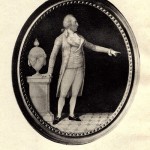Forgotten Anglo-Irish Inventor Anticipates the Modern Age July 21, 2011
Author: Beach Combing | in : Modern , trackbackThe passage that follows is a remarkable piece of dream engineering from the latter half of the eighteenth century. It was the creation of the obscure but fascinating Richard Lovell Edgeworth (obit 1817), one of those men cursed to have ideas that his day could not possibly understand or produce: an Anglo-Irish Leonoardo da Vinci though with more circumspection and less beard.
I was riding one day in a country, that was enclosed in a country, that was enclosed by many walls of an uncommon height; and upon its being asserted, that it would be impossible for a person to leap such walls, I offered a wager to produce a wooden horse, that should carry me safely over the highest wall in the country. It struck me that, if a machine were made with eight legs, four only of which should stand upon the ground at one time; if the remaining body were divided into two parts, sliding or rather rolling on cylinders, one of the parts, and the legs belonging to it, might in two efforts be projected over the wall by a person in the machine; and the legs belonging to this part might be let down to the ground, and then the other half o the machine might have its legs drawn up and be projected over the wall, and so on, alternately. The idea by degrees developed itself in my mind so as to make me perceive, that as one half of the machine was always a road for the other half, and that such a machine never rolled upon the ground, a carriage might be made which should carry a road for itself. It is already certain, that a carriage moving on an iron rail-way may be drawn with a fourth part of the force requisite to draw it on a common road. After having made a number of models of my machine, that should carry and lay down its own road, I took out a patent to secure to myself the principle; but the term of my patent has been long since expired, without my having been able to unite to my satisfaction in this machine strength with sufficient lightness, and with regular motion, so as to obtain the advantages I proposed. As an encouragement to perseverance, I assure my readers, that I never lost sight of this scheme during forty years; that I have made considerably above one hundred working models upon this principle, in a great variety of forms; and that, although I have not yet been able to accomplish my project, I am still satisfied that it is feasible. The experience, which I have acquired by this industry, has overpaid me for the trifling disappointments I have met with; and I have gained far more in amusement, than I have lost by unsuccessful labour. Indeed the only mortification that affected me was my discovering many years after I had taken out my patent, that the rudiments of my whole scheme were mentioned in an obscure memoir of the French Academy.
An obscure memoir of the French Academy: isn’t that always the way…
This passage is worth treasuring because it contains the essence of invention ‘the idea by degrees developed’, the meditation and unimportance of straightforward success and the forty odd years spent on this vain and surely insane endeavour. And yet, and yet… as Edgeworth’s most sympathetic biographer would have it: ‘it was not all nonsense; it looked forward to the caterpillar track, the tank and the train’ (130). In the early industrial revolution Edgeworth was anticipating some of the monsters of modernity that would transform his country from bumpkin ‘Merry Englande’ to Great Brit Inc and win the First World War. Fair play to you, Richard.
Also, just for the record, Edgeworth created an umbrella for haystacks
Any other inventions before their time? drbeachcombing AT yahoo DOT com



